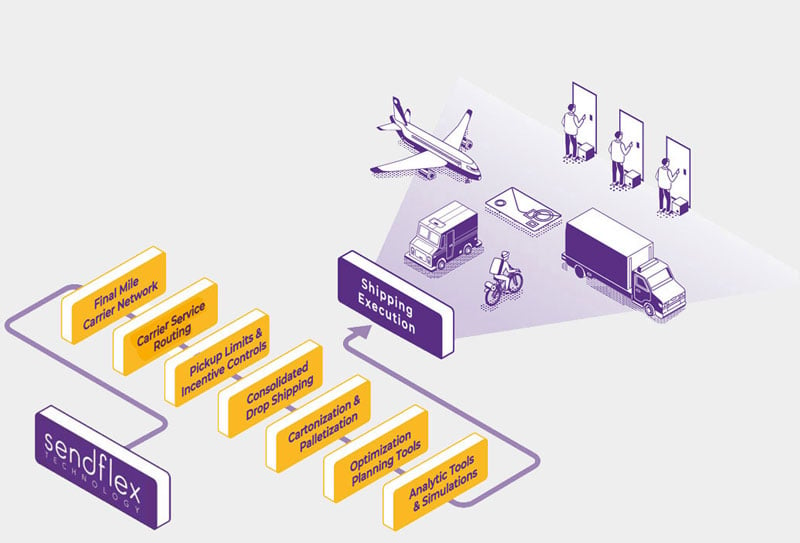Article: Ferris Bueller and the Legacy Shipping System Challenge
Dynamic market forces mean parcel shipping systems need to be more intelligent, adaptive, and less reliant on expensive technical resources. Flexibility and agility are vital to keeping up with change. Welcome to the age of final-mile shipping and TMS optimization.
To paraphrase philosopher Ferris Bueller, eCommerce moves pretty fast. If you don't stop and look around once in a while, you could miss it.
The truth is, the parcel shipping industry has been wholly — and rapidly — transformed by eCommerce. We're still reeling from all the changes, as businesses and carriers alike scramble to cope with skyrocketing volumes, diminished capacity, higher costs, and impossibly high customer expectations for more (free) shipping options, a better sustainability experience, and faster delivery.

The challenge for omnichannel fulfillment and carrier diversification
Moving from a system that only manages a few carriers to a multi-carrier shipping system that supports a few hundred carriers presents challenges unique to the 2020's.
Most shippers struggle if they attempt to make a legacy parcel shipping system do what it wasn't really designed to do out-of-the-box. Rehabbing a legacy system requires expensive programming and long project timelines. Hard-coded business rules make it difficult to adapt to change.
For years shippers using less-than-truckload (LTL) and truckload (TL) modes have used freight TMS systems to cope with managing the complexity of a very diverse network of carriers. They provide logistics managers with powerful configuration tools that optimize B2B consolidations, carrier selections, freight optimization, rating, and load planning, without having to engage expensive programming resources.
Whereas the traditional "duopolized" parcel industry has not had to manage as much complexity. Parcel shippers were used to picking a primary carrier and use all of their services to make all deliveries. That is why freight TMS systems have never incorporated B2C parcel management. Those days are over.
How the new generation of TMS optimization tools simplifies final-mile shipping and parcel planning
Today shippers can have the best of both worlds when it comes to managing final-mile shipping decisions. A final-mile TMS optimization platform lets logistics managers and non-programmers more easily configure optimization instructions in the following areas:
1) Diversified Carrier Service Selection: Omnichannel shipping strategies require moving from a single primary parcel carrier shipping from a few DCs to a diversified mix of regional, local, and gig-economy carriers with different capabilities, constraints, and preferences shipping from a network of pick-up locations. Managers need to be able to easily change carrier service selection rules based on variables such as:
- Delivery area, including city, state, postal code, zone, and other location-specific data elements
- Transit time, with the ability to weigh transit times and cost based on customer tier and location
- Shipment attributes, including weight, dimensions, shape, hazardous freight category, fragility, customer preference, value, and other SKU characteristics
- Pick-up limits, including pick-up cut-off times, number of packages, total cube, and other constraints imposed by carriers
- Carrier incentive targets, including routing based on accumulated year-to-date run rates required to achieve incentive targets
- Pick-up locations, including routing based on cost and transit times from multiple pickup locations
- Delivery performance, including promote or demote carrier ranking and selection based on performance to specific delivery areas
- Accessorials, including service selections based on availability (or avoidance) of accessorial services and surcharges such as DIM factors, over-the-threshold, lift gate, dwell time, etc.
2) Packing: One way to predict shipping costs in order entry and optimize available capacity is to ensure orders are packed in the most transportation cost-effective manner more accurately. By applying algorithms based on SKU size, dimensions, product and packaging shapes, and available container sizes, you can ""take the air out"" out of packaging, optimize cube utilization, and minimize costs and waste.
3) Sustainability: Most of us have had the experience of receiving shipments in cartons that are way too big for the contents inside, containing wasteful dunnage. Increasingly, customers are demanding a more sustainable experience. In addition to optimizing packing, sustainability performance factors can be applied to boost the rank of carriers that subscribe to carbon reduction policies. All things being equal, shippers with a commitment to sustainability need to select carriers that rank highest with 3rd party organization like CDP, which measures corporate environmental impact.
4) Customer Tier: Amazon has proven that offering preferential shipping fees and delivery time promises based on customer tier (i.e., Prime) is an excellent way to strengthen customer loyalty. Shipment rules like these can be applied dynamically during the order entry process and enforced during the shipping process.
Flexibility and the ability to stay current in a constantly changing logistics environment will remain essential competitive differentiators, as shippers master omnichannel fulfillment.
That’s why it’s an excellent time to look at a final-mile TMS optimization platform. A cloud-based TMS complements legacy shipping systems by optimizing final-mile shipping costs, capacity, and shippers’ customer delivery experience.
As philosopher Ferris once said: ""The question isn't what are we going to do. The question is what aren't we going to do." If you are ready to do something about optimizing final-mile shipping, contact us.

LEARN
Download Top 10 Things Retailers Can Do to Optimize Their Customers' Delivery Experience
EBOOK
Learn how to optimize the quality and cost of your D2C delivery experience
Shipping technology developers and integrators, 3PLs, and shippers need to shift the focus from automating shipping processes to optimizing the quality of a seamless D2C delivery experience. Here's how.
DELIVERY CONSULTATION
See What Sendflex Can Do for You
Are you struggling to keep up with the consumer demand for faster, cheaper delivery service options? Is it time for a smart multi-carrier parcel solution?
Whether deployed on premise or accessed from the cloud, our shipping platform apps and APIs support your entire extended enterprise: carrier selection, rating and routing, cartonization, shipping and drop shipping, tracking, and returns.
